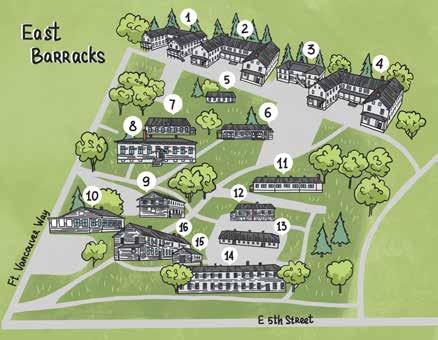
3 minute read
Parade Ground & Bandstand
Social events, such as parades, dances, and concerts, helped establish and maintain positive public relations between the nineteenth century U.S. Army and neighboring communities.
At Vancouver Barracks, military bands often served as local ambassadors, providing free public concerts in local cities and at the post. During summer months, many of the post’s concerts and social events centered around the bandstand.
Advertisement

Through historical and archaeological evidence, we know of the presence of three bandstands at the post.
The first appears on maps from 1870. It was constructed on the parade ground south of the Grant House, slightly to the east of the current bandstand.
By the mid-1880s it had been replaced by a fountain, and the second bandstand had been constructed on the extreme west end of the parade ground.
It, in turn, was supplanted by a third bandstand built around 1906 on the east end of the parade ground, which stood until 1943.
The current bandstand is a reconstruction built in the 1980s, meant to duplicate the post’s first bandstand.
Like its predecessors, it serves as the social center of the site, hosting speeches, ceremonies, weddings, commemorations, and – continuing the rich legacy of the site – military concerts.
East Barracks
The National Park System is responsible for the area known as the Western Barracks and the City of Vancouver (maintained by the Historic Trust) cares for the Eastern Barracks. Currently none of the buildings are open to the public but markers and information panels offer a self-guided tour through the first and for many years the most important military installation in the Pacific Northwest.
3 Post Headquarters (#991)
5 (#704) Barber Shop
6 (#725) JAG
7 (#722) Mess Hall
8 (#721) Auditorium
9 (#746) Band Training Building
10 (#748) Motor Shop Building
11 (#728) Finance Office
12 (#733) Mess Hall
13 (#754) AFFEES
14 (#786) Wood Shop
15 (#753) Storage.
16 (#752) Quartermaster Storehouse
Double Infantry Barracks
Front and back view of the barracks are quite different. In the beginning I often thought I was looking at two sets of buildings.
1. Barracks - Building 987 built in 1906
2. Barracks Building 989 built in 1904
4. Barracks Building 993 built in 1906
Typically these barracks held 180 soldiers and NCO officers.

Clark County Veterans Monument Dedicated [1998] to those who died in defense of our Country in the Spanish-American War, World Wars I and II.
704 Barber shop then office building 1934. Barbers in the military at this time could be either civilian or military. The Barracks employed many civilians during the 164 years in Vancouver providing jobs and an economic boost to the area.
725 JAG (Judge Advocate General) building. Mandated with the mission of defending the Army and its Soldiers in all military legal matters. At one time was also the Post Exchange with a restaurant.
722 [1914] This small building next to the Gymnasium served as a Mess Hall and later as an Army Reserve Recruitment Office.
723 Auditorium (Gymnasium) [1904-1905]. Front view. It was important for morale to provide reccreation for the soldiers. It also helped to lower work for the JAG folks defending the mischief and disorderly conduct soldiers might get into off base.
746 [1905] Workshops - 104th [1940] Division Band Training Building. Military bands played an important role both for soldiers and as social ambassadors in local communities. Free public concerts at the Fort Bandstand were widely attended.
748 Motor Repair Shop 1918-1919. The Motor Transport Corps (MTC) was formed in August 1918 and it did not take long for Vancouver Barracks to step up with its own first motor repair shop.
#728 built in 1941 as a Finance Office. In 1941 the post was at its height with billets for 250 officers and over 7000 soldiers in transit for WWII assignments. Today the building is used as headquarters for the Bureau of Indian Affairs.
#733 built in 1919 as a Mess Hall. Vancouver Barracks in 1919 was a World War I demobilization center with 30,000 leaving the army from here. In 1920 only a small presence of Company B, 32nd Infantry remained until the next armed conflict.
754 Quartermaster Shop now the AFEES (Army & Air Force Exchange Service). The first military PX began at Vancouver Barracks as a way to keep soldiers entertained
786 Workshop built in 1905-1906. Later used as Wood Shop and Red Cross. Soldiers carry out many roles of service that do not involve actual fighting or keeping peace. Today there are over 10,000 different occupational specialties in the military.
753 [1917] Small building built for storage. At one time the barracks consisted of as many as 300 buildings many of which were moved or torn down making way for other functions as needed.
752 [1905] Quartermaster Storehouse - one time Postal Exchange. The quartermaster was the officer in charge of supply support for soldiers. Ulysses S. Grant was the quartermaster during his time at Vancouver Barracks.







